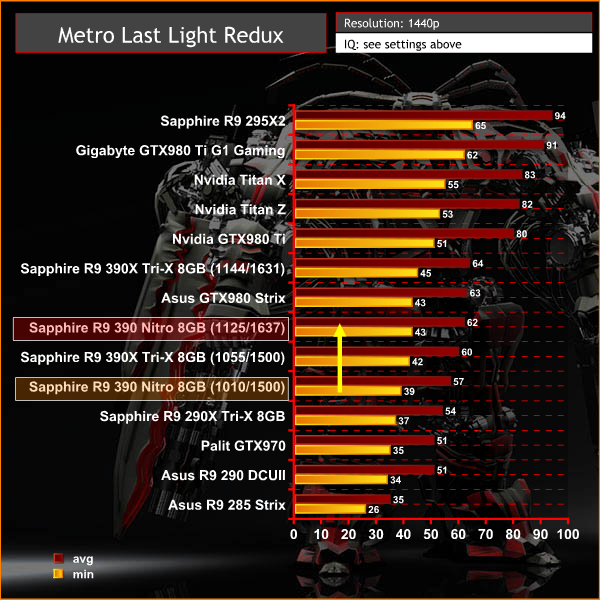

- #R9 390 metro last light benchmark install
- #R9 390 metro last light benchmark driver
- #R9 390 metro last light benchmark upgrade
Micro-stutter can be so extreme in some games and driver sets that SLI becomes undesirable, even if average FPS is improved over single-card configurations. GPUs render alternating frames when using the AFR technique more explicitly, GPU A will render all odd frames (1, 3, 5, 7) while GPU B renders all even frames (0, 2, 4, 6). SLI and CrossFire are also historically prone to micro- stuttering as a result of their dual-processing technique (normally AFR, or alternate frame rendering). It's almost always better to buy a newer, single card once that happens, as the spiked prices are hardly sane or good value. Almost every time a card exits official production, prices spike on retailers and second-hand markets. Also in that scenario, we'd always recommend buying that second card (if truly desired) before it exits production. In the event of the first scenario – where the user already owns one GTX 970 and is considering a second – the value considerations are different and will be discussed only in the conclusion.
#R9 390 metro last light benchmark upgrade
There are two primary scenarios where SLI or CrossFire are used: A later upgrade when half the configuration is already owned and a day-one, brand new build. EVGA GTX 970 SuperSC Specsįrom our previous article: Considerations of SLI Overclocking won't be tested until the review. PowerColor's Devil 13 is equipped with 16GB of GDDR5 memory, but that's not “stackable” memory for any of the games we tested each GPU has access to its own 8GB GDDR5 pool, and they cannot share memory pools to exceed 8GB in DirectX 11.Īt its stock speeds, the Devil 13 runs a core clock of 1100MHz and memory clock of 1350MHz. Granted, that's the same as you'd find for most dual-card configurations, it just looks impressive on one card. The power block is the most impressive – 32 pins of power (4x8-pin headers). The Devil 13 uses a three-fan array for cooling, each using a five-fin scoop design. The card runs for $600 – similarly priced to dual-GTX 970s (ranging from ~$620-$660) – but has a pretty massive $100 MIR right now. PowerColor goes heavy on the metals for this card, and that's something that we'll look at more closely in the forthcoming, standalone review – sag is definitely a concern. The weight primarily comes from a rigid backplate for structural support, opposed by a thick alloy heatsink under the faceplate. It's a single-card solution branded as “dual-core,” pursuant to the existence of two R9 390 GPUs on the PCB.

PowerColor's Devil 13 video card is a three-slot, five-pound behemoth. PowerColor Devil 13 Dual-Core R9 390 Specs Model This is critical to our testing as it lowers the ambient noise level of the room.CrossFire R9 390 vs. A Corsair AX860i digital power supply provides clean power to the system and is also silent as the fan hardly ever spins up. The OCZ Vertex 460 240GB SSD was run with latest firmware available. This profile defaults to 2133MHz with 1.65v and 11-12-12-30 1T memory timings. The Kingston HyperX 10th Anniversary 16GB 2400MHz quad channel memory kit was set to XMP Profile #2. We went with the Intel Core i7-4960X Ivy Bridge-E processor to power this platform as it is PCIe 3.0 certified, so all graphics cards are tested with PCI Express Gen 3 enabled. The Intel X79 platform that we used to test the all of the video cards was running the ASUS P9X79-E WS motherboard with BIOS 1704 that came out on. There has been some concern of people testing a cold card versus a hot card, but we’ve always done out testing ‘hot’ since the site started back more than a decade ago.
#R9 390 metro last light benchmark install
All testing was done using a fresh install of Windows 10 Pro 64-bit and benchmarks were completed on the desktop with no other software programs running. Before we look at the numbers, let’s take a brief look at the test system that was used.


 0 kommentar(er)
0 kommentar(er)
